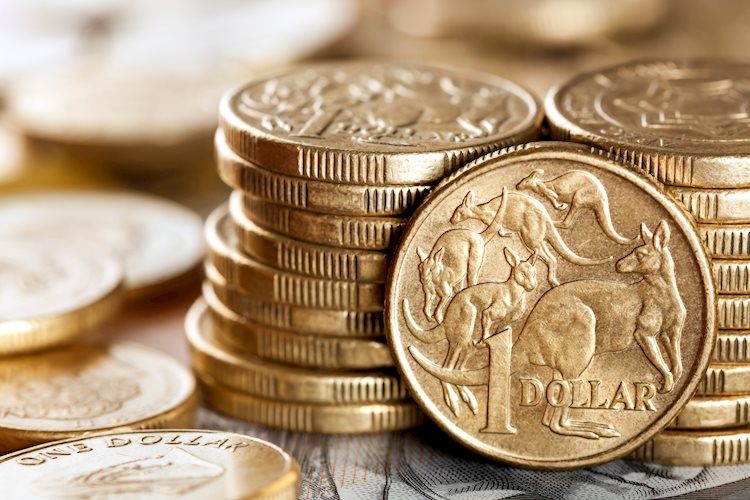- AUD rose against USD due to US inflation reduction and a potential dovish stance from the Fed.
- Soft PCE data from the US may benefit the Aussie policy divergence between the RBA and Fed.
- RBA’s delayed rate cuts could bolster the Aussie, contrasting with other G10 central banks’ reduction strategies.
Friday’s session recorded a significant uplift in the Australian Dollar (AUD) against the US Dollar following an unexpected inflation reduction in the US in May. As a result, expectations of a possibly dovish stance from the Federal Reserve (Fed) grew, leading to a likely divergence in policy with the Reserve Bank of Australia (RBA).
The Australian economy demonstrates minor signs of weakness. However, the heightened inflation rates maintain a stubborn resilience, preventing the RBA from implementing potential rate cuts. The RBA is foreseen delaying rate cuts, making it one of the last G10 country central banks to adopt a reduction policy. These delayed cuts might enhance the further strengthening of the Aussie.
Daily digest market movers: Aussie continues to strengthen amid robust CPI figures
- In terms of the data at hand, the Australian Dollar’s strength was bolstered by increased expectations of the RBA further hiking rates after hot Consumer Price Index (CPI) data reported earlier in the week.
- Market indications are now pricing in approximately 40% odds of a 25-basis-point rate hike from RBA on September 24, extending to 50% leading up to November 5.
- US inflation fell to 2.6% YoY in May from 2.7% in April, according to the US Bureau of Economic Analysis. This decrease matched market expectations.
- On a monthly basis, the Personal Consumption Expenditures (PCE) Price Index remained static. The core PCE Price Index rose by 2.6%, a decrease from the 2.8% escalation that was recorded in April.
- As a result, this downtrend toward the Fed’s 2.0% target bumped the probability of a Fed interest rate cut in September to 66%, up from 64% prior to the PCE release, as per the CME FedWatch Tool.
Technical analysis: AUD/USD maintains buyer interest above 20-day SMA
From a technical outlook, the indicators displayed signs of recovery with the Relative Strength Index (RSI) staying above 50, and the Moving Average Convergence Divergence (MACD) printing a fresh green bar. Critical to the future momentum of the pair will be the defense of the 20-day Simple Moving Average (SMA) at 0.6640. As long as buyers manage to sustain above this key level, the future outlook appears promising.
Notably, on Friday, the pair managed to lift back above the 20-day SMA, after dipping to a low of 0.6620, a key indication that buyer defenses remain robust.
RBA FAQs
The Reserve Bank of Australia (RBA) sets interest rates and manages monetary policy for Australia. Decisions are made by a board of governors at 11 meetings a year and ad hoc emergency meetings as required. The RBA’s primary mandate is to maintain price stability, which means an inflation rate of 2-3%, but also “..to contribute to the stability of the currency, full employment, and the economic prosperity and welfare of the Australian people.” Its main tool for achieving this is by raising or lowering interest rates. Relatively high interest rates will strengthen the Australian Dollar (AUD) and vice versa. Other RBA tools include quantitative easing and tightening.
While inflation had always traditionally been thought of as a negative factor for currencies since it lowers the value of money in general, the opposite has actually been the case in modern times with the relaxation of cross-border capital controls. Moderately higher inflation now tends to lead central banks to put up their interest rates, which in turn has the effect of attracting more capital inflows from global investors seeking a lucrative place to keep their money. This increases demand for the local currency, which in the case of Australia is the Aussie Dollar.
Macroeconomic data gauges the health of an economy and can have an impact on the value of its currency. Investors prefer to invest their capital in economies that are safe and growing rather than precarious and shrinking. Greater capital inflows increase the aggregate demand and value of the domestic currency. Classic indicators, such as GDP, Manufacturing and Services PMIs, employment, and consumer sentiment surveys can influence AUD. A strong economy may encourage the Reserve Bank of Australia to put up interest rates, also supporting AUD.
Quantitative Easing (QE) is a tool used in extreme situations when lowering interest rates is not enough to restore the flow of credit in the economy. QE is the process by which the Reserve Bank of Australia (RBA) prints Australian Dollars (AUD) for the purpose of buying assets – usually government or corporate bonds – from financial institutions, thereby providing them with much-needed liquidity. QE usually results in a weaker AUD.
Quantitative tightening (QT) is the reverse of QE. It is undertaken after QE when an economic recovery is underway and inflation starts rising. Whilst in QE the Reserve Bank of Australia (RBA) purchases government and corporate bonds from financial institutions to provide them with liquidity, in QT the RBA stops buying more assets, and stops reinvesting the principal maturing on the bonds it already holds. It would be positive (or bullish) for the Australian Dollar.
